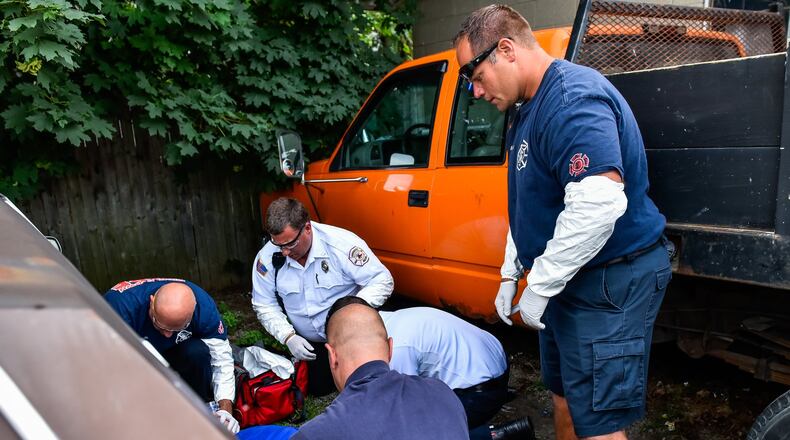There are many toxicology reports yet to be returned, so coroner officials expect those numbers to increase when the official totals are released in late February or early March.
RELATED: Butler County spike in opioid overdoses prompts warning
But the first 10 months of 2017 alone made last year the worst regarding overdose deaths, and deaths related to heroin, fentanyl and/or carfentanil.
“Heroin’s bad enough, but when it’s laced with fentanyl and carfentanil …,” said Fairfield Police Chief Mike Dickey. “It’s a critical problem that all agencies, including the DEA, have made a major focus in attacking.”
Dickey said police agencies are hearing about heroin or opioid overdoses “almost on a daily basis,” but there are still some people who are almost numb to the issue because it hasn’t directly impacted them.
“I sincerely hope that 2018 will be the point when we reach critical mass on this epidemic,” he said. “If the public across the country has not recognized the severity of this problem, then it will likely affect someone in their immediate family or social circle. There isn’t a day that goes by that our police or our EMS service don’t get a call for an opioid overdose.”
Dickey said Fairfield’s Quick Response Team — which includes an officer, medic and a social services professional who help those who overdose into treatment — and similar response teams in other communities will be more active in 2018 “just by the sheer volume that overdoses are occurring. I would suspect all the QRTs will have an increased workload.”
RELATED: 7 powerful consequences of the opioid epidemic
As Butler County police and fire departments take the issue head-on in 2018, it needs to be a multi-faceted approach, not just relying on delivering those who overdose into treatment, said Middletown police Lt. David Birk. There needs to be more education and stricter penalties for those who sell heroin, he said.
A hit of heroin is a tenth of a gram, he said, and if a dealers have less than five grams of heroin — which is 50 doses — they can get probation and parole.
“Individuals aren’t selling it to continue their habit,” he said. “They’re selling it to make money. We need tougher penalties for that individual selling. You don’t go to prison until it’s at least an F-3.”
Birk said not only will Middletown continue the city’s Heroin Response Team program (similar programs in other communities are called Quick Response Teams), but other programs, such as a newer effort with Atrium Medical Center.
“We’ve got bigger and stronger relationships with the hospital, and we’re going to continue that,” he said.
The hospital will offer referrals to the HRT of patients who may have an addiction, and Birk said the city “started to build that this past summer” and called the referral levels in December “excellent.”
President Donald Trump declared the opioid epidemic a national health crisis in October, which means more people will have access to treatment. Just in Ohio, opioid addiction, abuse and overdose deaths have cost Ohio between $6.6 billion to $8.8 billion, according to a report from the C. William Swank Program in Rural-Urban Policy at The Ohio State University.
For comparison, Ohio spent $8.2 billion on public education in 2015, according to the report.
RELATED: President Trump declares opioid epidemic a public health crisis
Umona Sharp, Opiate Recovery Outreach coordinator with Butler County Behavioral Health, has worked with a number of police agencies' Quick Response Teams to help people find treatment.
“We have worked together to solve some of the barriers that cause people to not get treatment, like transportation, health insurance, a photo ID (which is needed for Medicaid), housing and employment,” she said.
Sharp, who’s been on the job just four months, said a lot more will be done in 2018, including working with Oxford on a health fair in May for those who need services and treatment.
“We’re doing good, and we’re making positive strides,” she said.
Overdose deaths in Butler County
The Butler County Coroner’s office has seen a dramatic increase in overdose deaths because of the heroin epidemic. It’s impacted the number of overall cases the coroner’s office handles on a yearly basis, which has seen a continual rise in the past several years.
2017*: 482 total cases | 204 overdose deaths | 166 opioid-related overdose deaths
2016: 453 total cases | 192 overdose deaths | 153 opioid-related overdose deaths
2015: 420 total cases | 189 overdose deaths | 149 opioid-related overdose deaths
2014: 400 total cases | 137 overdose deaths | 103 opioid-related overdose deaths
2013: 339 total cases | 118 overdose deaths | 60 opioid-related overdose deaths
2012: 325 total cases | 103 overdose deaths | 30 opioid-related overdose deaths
*Through Oct. 31, 2017
Source: Butler County Coroner’s Office
About the Author

